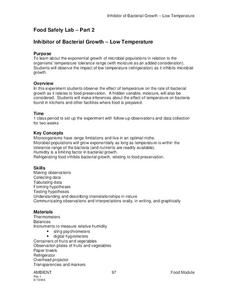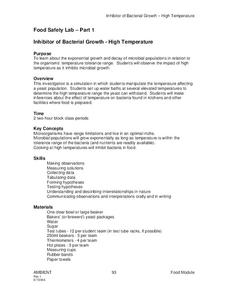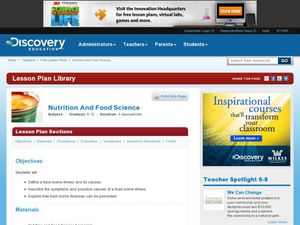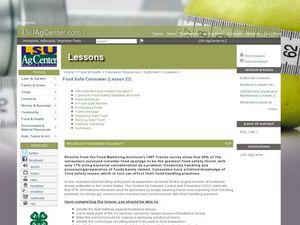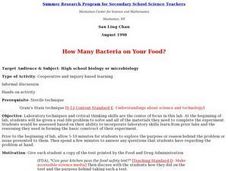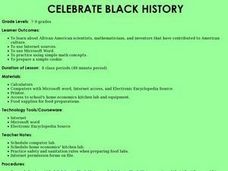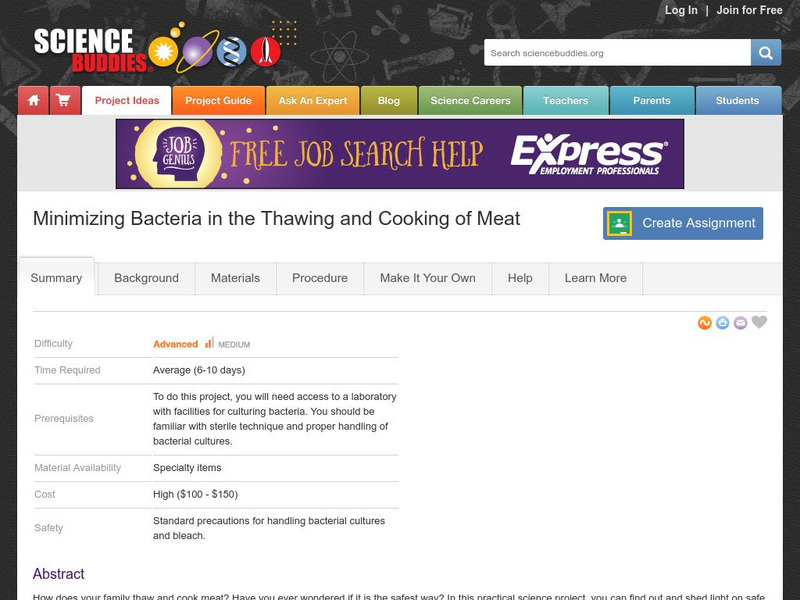University of Rhode Island
Food Safety Smart Curriculum
This is a must-have resource with everything you'll need for studying food safety with your pupils. From handwashing scorecards and cleaning kitchen surfaces to navigating the world of microbes and food-borne illnesses,...
Curated OER
Food Safety Lab
Students use the scientific method to investigate the role of temperature in microbial growth. In this food preservation lesson, students set up an experiment with fruit in room temperature and in a refrigerator. They record the...
Curated OER
Food Safety Lab
Students determine the optimal living conditions for yeast and apply these results to microbes in food. In this microbiology lab lesson plan, students observe the reaction of yeast to elevated temperatures. They relate these results to...
Curated OER
Food Safety Lab-Part 3 Cross Contamination andHygiene
Students observe the effect of croos contamination as they inoculate orange juice with penicillin mold from the refrigeration lab and active yeast solution from the sterilization lab. They experience a simulation of passing bacteria...
Curated OER
Kitchen Equip and Lab Procedures - Level I
Students, in groups, record at least four pieces of equipment that fit a specified category as well as a safety tip to observe when using the equipment.
Curated OER
Nutrition and Food Science
High schoolers examine the causes and symptoms of food-borne illnesses and ways to prevent them. In this nutrition lesson students work in teams to investigate a type of food-borne illness and present a scenario about it.
Curated OER
Food Safe Consumer
Young scholars explain how to prepare and keep food safely. In this health science instructional activity, students research common mistakes and tips for maintaining a clean kitchen. They identify main causes of foodborne diseases.
Curated OER
Bacteria
Young scholars study food borne illnesses and what foods are more likely to carry them. In this investigative lesson students examine harmful bacteria.
Curated OER
How Many Bacteria on Your Food?
High schoolers discuss and conduct a food safety experiment which looks at bacteria and food poisoning. They swab the other area of some food and grow bacteria in an agar plate.
Curated OER
Unit: Home: Examination Five
Write short answers or fill in the blank to the following questions and statements. Use complete sentences when answering questions. Questions included are, but not limiterd to Why should raw and cooked foods be stored separately in the...
Curated OER
Microwave Introduction
Learners take true and false pretest, and explore and practice basic principles of microwave cooking and how to use and care for it properly while preparing foods. Students watch teacher demonstration and then prepare their own bags of...
Curated OER
Activity #17 Liquid Density and Temperature
Students comprehend that hot water rises up through cold water but cold water does not rixe in hot water. They comprehend that water at temperatures above 4oC decreases in density with increases in temperature. Students answer lab...
Curated OER
Celebrate Black History
Students research African-American mathematicians. In this middle school mathematics instructional activity, students celebrate Black History by conducting Internet research on an African-American, mathematicians or...
Massachusetts Institute of Technology
Mit: Open Course Ware: Advanced Kitchen Chemistry
College-level advanced course on kitchen chemistry. Course topics highlight the scientific exploration of all types of food. Features online include downloadable assignments and readings, and a number of food chemistry-related links.
Science Buddies
Science Buddies: Minimizing Bacteria in the Thawing and Cooking of Meat
Here's a practical project that sheds light on safe practices in the kitchen. Use this information to determine which method of defrosting meat is safest and which method of cooking kills the most bacteria.

